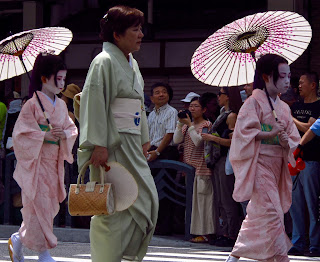Gion Matsuri had its beginnings in the Kyoto plague of 869. This was blamed on the god of pestilence, Gozu Tenno. Praying for deliverance from the epidemic and an end to the curse the people paraded 66 hoko (spears) and the mikoshi (a wheelless vehicle for transporting a deity) from Yasaka Shrine through the streets of Kyoto. This seemed to work, so they repeated the ritual the next year, and the year after that, and have been doing so for more than 1,100 years. So every July the mikoshi of Yasaka Shrine get a little vacation.
By the Edo Period (1603 - 1868) the hoko had evolved into something altogether different than a simple spear. The wealthy and powerful merchant class began building elaborate wooden structures, what we might call a float in the US, with and without wheels to parade through the streets.
This parade on the 17th of July, called the Yama Hoko Junko, is the main draw of Gion Matsuri. The tallest hoko reach a height of more than 8 meters (26 feet) and must be accessed via a temporary bridge built from second story windows of adjacent buildings. Assembled using beautifully complex rope knots (no nails or screws!) and decorated with exquisite textiles these are a truly impressive sight and totally unique to Kyoto. The strength and bravado of the battalion of men that pull the hoko (weighing up to 12 tons) through the streets is also an awesome spectacle.
Sweat, brawn and pride is a big part of Gion Matsuri. It seems tailor-made for men both young and old wishing to display their swagger. Yocho is the name for the men involved in the lifting, pushing and pulling of heavy, sometimes dangerous things during the festival. Dressed in their distinctive white cotton happi jackets emblazoned with a blue festival mon (crest) and often only a fundoshi (loincloth) underneath they are easy to spot. For motivation and coordination of their tasks they have a variety of chants that would not be out of place in a football ground.
The women and children who participate in Gion Matsuri are a sharp contrast to the yocho. If they aren't decked out in colorful period costumes with faces painted white, they are wearing simple, elegant yukata (lightweight summer kimono), parasols and uchiwa (flat fan) in hand. They add a bit of that quintessential Japanese grace and kawaii (cute) to the festival.
As a gaijin I may never fully grasp the significance and the myriad religious and historical references of Gion Matsuri. But maybe that's not important. Many of the Japanese people I spoke to don't either. It is the spectacle - the sights, sounds and smells of the ancient capital. That is why thousands of people descend on Kyoto in July.






